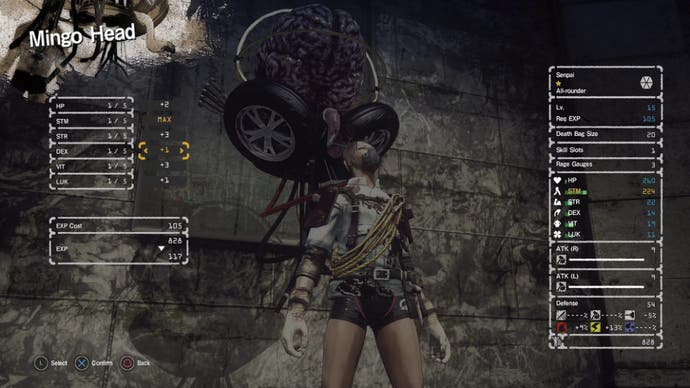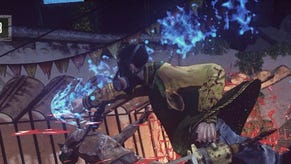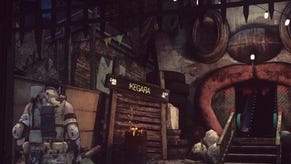Let it Die is Grasshopper's refreshingly different return to form
Don't fear the reaper.
Grasshopper Manufacture is known for its excess and eccentricity, but not for its craft. Its titles like Killer7 and Shadows of the Damned were strong on style, atmosphere, and attitude, but always fell a little limp in their core mechanics, with only No More Heroes and its sequel standing proud as a uniquely enjoyable addition to the third-person action genre. The more Grasshopper has tried to ape its competitors like Resident Evil 4 and Devil May Cry, the more characterless and insignificant the studio's output felt. Let it Die is Grasshopper's furthest deviation in this direction, opting to shuffle its narrative quirks to the sidelines in favour of a distinctly Dark Souls-flavoured third-person "survival action" affair. Only this time, Grasshopper got it right.
Let it Die's different, design-first flavour should come as no surprise to those who followed its development. As publisher (and now Grasshopper owner) GungHo Online Entertainment was quick to point out upon my visit to its Tokyo headquarters, Grasshopper founder and creative director Suda 51 was less involved in this project's development as he'd been in the studio's previous outings. This time Killer is Dead director Hideyuki Shin took the reins. Shin, who has more experience as a designer than a storyteller, is given a stronger chance to shine this time around with a title that's a more focused showcase for Grasshopper's hidden talents.
This may not be apparent in the first half-hour, however. Let it Die's opening act is heavy on awkwardly lackadaisical cutscenes, oddball character introductions, and reams of text explaining the complex systems that make up this procedurally-generated hack-and-slash affair. The story, which concerns a demonic tower sprouting in the middle of Tokyo while a skateboarding grim reaper, Uncle Death, sets frozen husks of former humans into said spire to uncover its mysterious source of power, is a dull paste of strange and generic. It lacks the skewed real world texture of its obvious inspirations like Escape From New York and The Warriors, while also failing to capture the surreal fever-dream stylings of Killer7 or El Topo. Let it Die still has a familiar Grasshopper personality - no one would mistake composer Akira Yamaoka's playfully sordid arrangements or a frog-collecting mechanic for anyone else's work - but, like the skater skeleton Uncle Death himself, it feels strange just for the sake of being strange rather than in service of anything.
Thankfully, what Let it Die lacks in its setup is more than made up for once the tutorial is out of the way. Suda has described Let it Die as a "survival action" game and it's an apt summation. More measured and methodical than Killer is Dead or No More Heroes, Let it Die pits player against fewer, tougher foes who can end a strong run at a moment's notice. Its closest comparison would be Dark Souls, with its similar stamina meter governing what attacks can be meted out, but there's a few key differences that give Let it Die a distinct flavour from From's masterful series.
For one, equipment breaks down very quickly in Let it Die. You're constantly running out of armaments and apparel. Not since Ghost 'n Goblins' Arthur have we seen a protagonist so swiftly switch from being a mighty armoured warrior to barehanded and barefoot. With a limited inventory and gear that tends to break after a few blows, there's a strong sense of just barely scraping by as you tiptoe around feasting on the frogs and rats scuttling this randomly-generated labyrinth of maniacal souls.
Your adversaries are fierce, too! Much more ferocious than From Software prepared me for, anyway. Upon first encountering a hoard of hooligans meandering about a sewer, I assumed I would be safe taking aim at them from an overlooking vantage point. Imagine my surprise when they all began sprinting towards me and leaping on ledges like a zombified Tarzan. These buggers are relentless too, so once they get a whiff of you, things are only going to get more unnerving until you thwart them off or die trying.
Making matters even more difficult are "Haters", i.e. a brand of enemy based around the skill level and gear of other fallen players. While Let it Die doesn't have direct PvP combat, you'll frequently find these overlevelled opponents roaming the catacombs. Amusingly, they'll slaughter other foes in their search for you, offering a moment of relief before the going really gets tough. One of my favourite moments in my six hours of Let it Die was when my lowly lvl 18 character defeated a lvl 30 Hater after my last melee weapon broke midway through the fight.
There is another form of online play in Let it Die, though I've only caught the faintest glimpse of it. Similar to Metal Gear Solid 5's Forward-Operating Base mode, players can infiltrate other people's hub's and steal their resources. I'm still a little lost on the details of this, and its balance to the rest of the game warrants further investigation, but it seems intriguing.

The real question is how Let it Die's micro-transactions gel with the rest of the game. So far, I've been pleasantly surprised at how gracefully it's been implemented. In its current form, it may even add to the game, as the grind to gain enough coin for a resurrection is a stiff enough penalty that death has real meaning here. But first, an explanation of how it all works.
There are two primary currencies in Let it Die: Death Medals and Kill Coins. Death Medals allow you continues that revive you on the spot. These are rare, though they can be purchased for real world money. ($4.99 for 10 of them, $13.99 for 30, or even less for larger bundles.) Kill Coins, however, are generously earned in-game and can revive your character with all their gear at your main hub. Should that prove too grueling, you can defeat your former self with a different character before reanimating them in a freezer. This is by far the most difficult method as it requires you to level up more than one character or you'll have an arduous challenge on your hands. Of my three characters, my main is lvl 25 while the other two are still mere babes at their default lvl one. Needless to say, this method wasn't successful in my situation. Worse, even getting to your former self costs in-game coins as you'll want to pay for the elevator shortcut to bring your newly awakened character to their fallen comrade several floors up.
It sounds cumbersome to revive oneself in Let it Die, and in many ways it is, though like Monster Hunter, the grind become part of the fun. You can find blueprints and crafting materials, shareable across multiple characters, while venturing forth with a less powerful character, so there's still a feeling of making progress (albeit at an occasionally molasses-coated pace). Thus far the ratio of earning Kill Coins to needing them for resurrection has felt pretty balanced with the temptation to snag one of the smaller Death Medal packs fairly mild. The question is whether it will stay that way as the game has its own inflation system: the higher your character's level, the more costly they are to revive. (Similarly, shortcuts to higher floors in the tower cost more coin to travel between.)
Let it Die isn't exactly the best in class - its cut-and-paste corridors, sluggish camera and somewhat stiff controls aren't going to fool anyone comparing this to a polished full-priced retail classic like Bloodborne (though it's cut from the same cloth as that game's Chalice Dungeons), but it's unique enough to be a worthwhile entry in its own right. With its systems-focused core Let it Die doesn't feel like an oldschool Grasshopper game, but it represents the Grasshopper we knew a decade ago when it bucked trends by bringing a hyper-violent splatterfest to the Wii - or Killer7 into existence. Let it Die carves a niche unto itself as a free-to-play survival-action game on console. It's something new, anyway, and while it's hard to say how Let it Die's economy will shape its design in the later stages, its first half-dozen hours mark it as a delightfully different curio in this ever competitive market.










